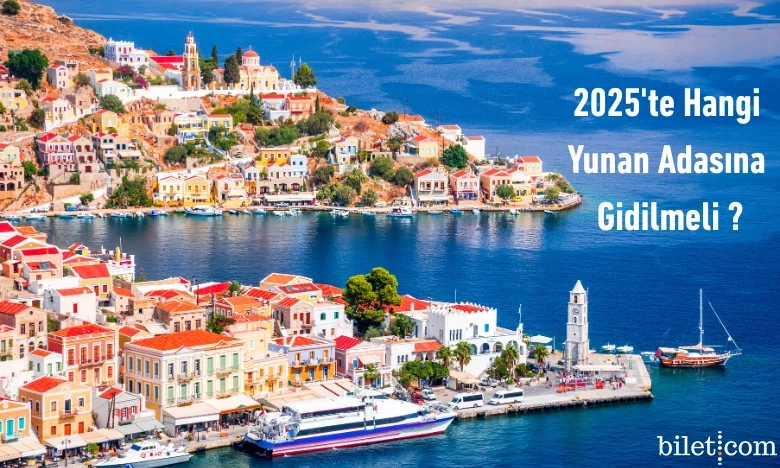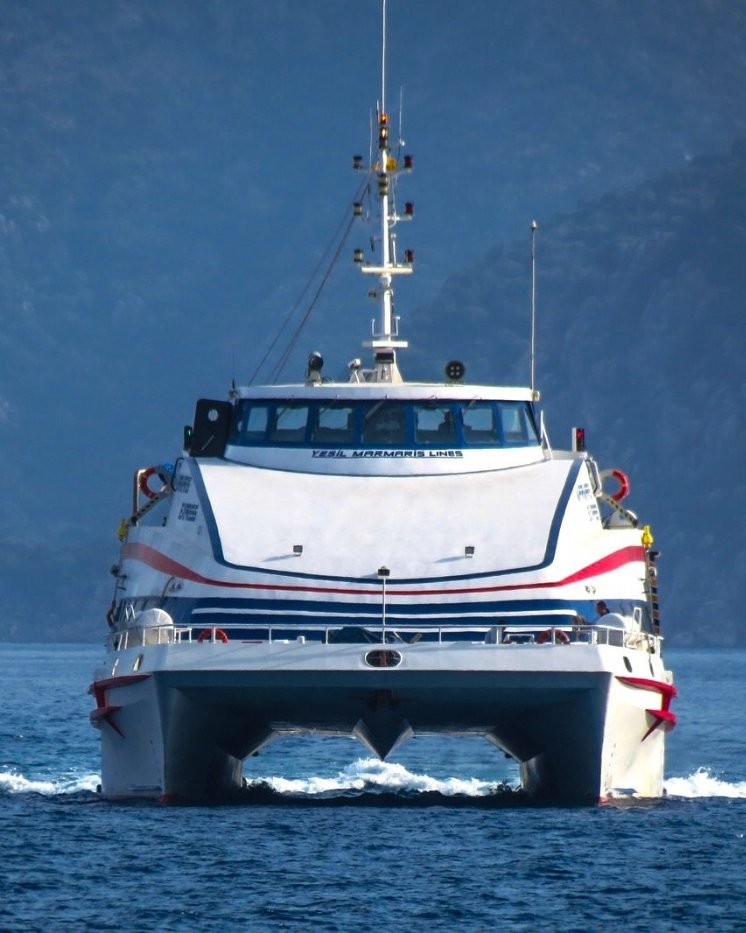Whether you are a first-time traveler or have traveled the Aegean before, this comprehensive guide will make it much easier for you to choose the most suitable Greek island for you in 2025. An informative and detailed article about 12 popular Greek islands that stand out with their history and natural beauty awaits you.
Kos Island : The Island of Healing Winds and Civilization
History: Kos, the birthplace of Hippocrates, is a center where the heart of ancient medicine beats. The ancient health temple of Asklepieion is considered one of the most advanced treatment centers of its time and is still standing today. In addition, Roman baths, mosaic villas and castle ruins offer visitors a journey through history. Fountains, mosques and baths from the Ottoman period bear witness to the multicultural history of the island.
Nature: Thanks to the flat structure of Kos, it is quite enjoyable to travel by bike. Palm-lined roads, long sandy beaches that meet the deep blue sea and beaches intertwined with nature make your holiday both relaxing and fun. Watching the sunset from Zia village is one of the most romantic experiences on the island.
Food and Drink: Fresh seafood, olive oil appetizers and garlicky “gyros” are delicacies that must be tasted in Kos. Turkish cuisine influences can also be felt in the menus; especially desserts with syrup and kebabs are blended with local flavors.
Who is it for?: Perfect for those who are going on a Greek island holiday for the first time, families with children, history enthusiasts and those looking for a relaxed but active holiday.
Lesvos: The Island of Art, Poetry and Olives
History: Lesbos, where Sappho, one of the most important female poets of antiquity, was born, has been a cultural center throughout history. The island is home to stone houses, mosques, baths and Byzantine ruins from the Ottoman period. Castles, open-air museums and traditional villages allow visitors to follow the traces of the past.
Nature: Lesbos has a fascinating nature with its slopes covered with thousands of years old olive trees, green hills and turquoise bays. Especially the town of Molivos is a photographic paradise with its stone streets, historical buildings and panoramic sea views.
Food & Drink: Lesbos, the ouzo production center of Greece, offers the best of this aniseed drink. The meze culture is very developed; various plates from stuffed calamari to marinated fish decorate the tables. The island's own olive oils and cheeses are also quite famous.
Who is it for?: Ideal for cultural explorers, gourmet travelers, and nature and art lovers looking for a leisurely vacation.
Samos: The Island of Wine and Science
History: Samos, the hometown of the famous mathematician Pythagoras, is an island that has shaped the history of science and philosophy. Archaeological sites such as a large temple dedicated to Hera, ancient theaters and a cave named after Pythagoras take visitors back in time.
Nature: The island's interior has hiking trails, waterfalls, forest paths and impressive landscapes, while Samos' beaches attract nature lovers with their clear waters and untouched nature.
Food & Drink: Samos wines made from Muscat grapes are known worldwide. Visitors can tour and taste the wines in the vineyards on the island. Local delicacies such as fish, snails and goat meat are also very popular.
Who is it for?: It is a perfect discovery island for those who want nature walks, local delicacies and history all together.
Patmos: Spiritual Calm and Mystical Atmosphere
History: Patmos is of great importance in the Christian world as the place where the Book of Revelation (Apocalypse), the last chapter of the Bible, was written. The cave of St. John and the Patmos Monastery make the island a spiritual center.
Nature: The natural structure of the island is rocky and quite calm. It offers a peaceful atmosphere with its quiet beaches, small coves and walking paths.
Food and Drink: Small but quality taverns serve the basic flavors of Greek cuisine. Olive oil dishes, seafood and homemade desserts attract attention.
Who is it for?: Suitable for those who want to make a spiritual journey, those who want to get away from the crowds, and those who love nature walks.
Kalymnos: Island of Adventurers
History: Kalymnos was famous for sponge diving in history. This heritage is still kept alive in the museums and traditions of the island. In the Sponge Museum, you can see both the artisanal past of the island and its connection with the sea.
Nature: Kalymnos is one of the most famous rock climbing resorts in the world. The cliffs and sheer cliffs are a magnet for professional and amateur climbers. Snorkeling and hiking are also popular.
Food and Drink: Seafood is also prominent here. Especially the various sea creatures obtained after sponge hunting enrich the local cuisine. Fish soup and octopus with lemon are among the delicacies unique to the island.
Who is it for?: Perfect for adventure-seeking sports lovers, those looking for alternative holidays and those who want to spend time in touch with nature.
Chios : The Land of Gum Trees
History: Chios Island bears the traces of many civilizations throughout history with artifacts from the Byzantine, Genoese and Ottoman periods. Structures such as the mansion of Neşet Bey of Chios, the village of Pyrgi decorated with stone houses and the Nea Moni Monastery, which is on the UNESCO World Heritage Tentative List, carry the richness of the past to the present.
Nature: The villages of Mastichochoria in the south of the island are surrounded by mastic trees, which grow only here in the world. Quiet beaches along the coast, paths ideal for nature walks and hidden coves offer visitors a peaceful but rich experience.
Food and Drink: Mastic liqueur, mastic ice cream, cookies and coffee are prominent products. Local wines and fresh seafood decorate the tables. It is possible to find flavors blending traditional Turkish and Greek cuisines on the island.
Who is it for?: It is perfect for gastronomy enthusiasts, those who want to discover natural products, and those who want to experience authentic villages and traditional life.
Mykonos : The Heart of the Party
History: Mykonos takes its name from Mykonos, the grandson of the God Apollo according to Greek mythology. In ancient times, it was a center of trade and religious ceremonies due to its proximity to the island of Delos . It was under various influences during the Byzantine, Venetian and Ottoman periods.Iconic landmarks of Mykonos include its 16th-century windmills , Panagia Paraportiani Church , narrow white streets, and small port.
Nature: Mykonos has the typical Cycladic architecture with its whitewashed houses, blue windows, bougainvillea-lined streets and golden beaches. Beaches such as Paradise , Super Paradise , Psarou and Ornos are filled with the sea during the day and DJ performances at night.Since the wind is strong, it is also suitable for water sports such as windsurfing and kiteboarding .
Food & Drink: Mykonos offers both traditional Greek and international cuisine in terms of gastronomy. The luxurious restaurants by the beach stand out with menus by Michelin-starred chefs. At the same time, the traditional taverns in the streets offer delightful meals with souvlaki, moussaka, fresh seafood and ouzo.Who is it for?: Young people, social media influencers, those who want luxury and entertainment.
Rhodes : The Island of Knights and the Sun
History: Rhodes is a living open-air museum with its medieval city walls and castle structures built by the Knights of Rhodes. The Old Town, which is on the UNESCO World Heritage List, has a fascinating atmosphere with its narrow stone streets, arched passages and Gothic buildings.
Nature: The west of the island is ideal for windsurfing, while the east coast has family-friendly, quiet beaches. The town of Lindos is picture-postcard-perfect with its snow-white houses and ancient acropolis. Butterfly Valley (Petaloudes) is home to millions of butterflies in summer.
Food and Drink: Traditional Greek meze, oven dishes and desserts specific to the island are quite common in Rhodes. It is very rich in seafood; fish such as calamari, octopus and sea bass are served in their freshest form.
Who is it for?: Ideal for those who want to experience both history and a seaside holiday, photography enthusiasts and those who enjoy the historical atmosphere.
Meis (Kastellorizo): Colorful Silence
History: Meis Island, or Kastellorizo in Greek, has hosted many civilizations throughout history. Due to its strategic location, it has remained under the rule of Ancient Greece, Rome, Byzantium, Ottoman and Italian. In the 1920s, it was taken over by the Italians, then by the British and in 1948 it became part of Greece. The name of the island is most likely derived from the expression “Red Castle” (Castello Rosso). The colorful houses lined up along the historic harbor, the Ottoman Mosque (now used as a museum), the Aya Yorgi Monastery and the ruins on the top of the island offer the opportunity to travel back in time.
Nature: Meis is the easternmost settlement among the Greek islands and is only 2.1 km away from the Kaş district of Turkey. It fascinates with its tranquility, clear sea and traditional architecture. The island, where there are no cars, is a getaway for those looking for peace.
One of the most fascinating natural wonders of the island is the Blue Grotto . Sunlight reflects into the cave, making the waters shimmer in turquoise and sapphire tones. The cave can only be entered by small boats.
Food and Drink: The fish restaurants and taverns in the port are small but delicious. Fresh seafood, grilled octopus, calamari and traditional Greek meze are especially popular. Most visitors from Turkey take the ferry from Kaş in the morning and spend the day eating here.
Who is it for?: Ideal for couples looking for silence and romance , History and culture enthusiasts will be interested in the island's architecture and historical sites, Nature lovers will find the environment suitable for swimming, cave tours and hiking, It offers an economical and enjoyable alternative for those who want to go on a day trip from Turkey.
Simi: An Island Like a Postcard
History: Its colourful neoclassical houses bear traces of the Italian and Ottoman periods. Symi was once an important port town, made rich by sponge diving and maritime trade.
Nature: Unique sea views can be watched from the hills reached by climbing through narrow streets behind the port. The island is surrounded by small beaches.
Food and Drink: Symi is especially famous for its shrimp. Fresh seafood and appetizers play a leading role in the seaside taverns.
Who is it for?: Ideal for aesthetically pleasing travelers, photography enthusiasts, and those who prefer calm but culturally rich destinations.
Leros: The Island of Silence and Alternative
History: Leros was the scene of intense fighting during World War II and has many war ruins, museums and old bunkers. At the same time, port towns built with Italian architecture give the island a different aesthetic.
Nature: Leros is a peaceful island, far from the touristic crowds, with its small coves and natural beauties. Areas such as Alinda and Agia Marina stand out with their quiet beaches. It is also very suitable for fishing and sea activities.
Food and Drink: Fish and octopus are especially prominent in the island cuisine. Leros's homemade wines and goat cheeses are delicacies that must be tried.
Who is it for?: It is a perfect choice for those looking for silence and a simple and natural holiday away from the crowds.







